Since the beginning of time, man has relied on machines to help him with the heaviest or repetitive tasks.
With the development of the industry, new problems concepts began to emerge. Those were well captured and caricatured in the Charlie Chaplin film “Modern Times” of 1936. Humanity began to realise the need to protect man from the risks that machines presented. Such led to the arrival of new concepts regarding their minimization that are being instilled still today.
Norms, directives and laws on the matter appeared, such as the Directive 2006/45 / EC, commonly known in Europe as the Machinery Directive. This Directive is followed in the European Economic Area by machine builders. In Portugal, it was transposed into the internal legal system through Decree-Law no. 103/2008 of 24 June.
At Controlar, there is a constant concern to comply with all the Essential Health and Safety Requirements in the Decree-Law no. 103/2008, from the design to the completion of the machine.
When designing or building a machine, these requirements are:
- obtained by the installation of safety components with the best protection index (PL), which is generated through risk assessments;
- proven by the application of the SISTEMA software that takes into account all the safety components installed in the machine;
- obtained by applying innovative or unusual measures, such as the use of programmable safety relays and / or collaborative robots.
What are the advantages of using collaborative robots?
Collaborative robots are designed to share the workspace with man and increase human capacity, facilitating the automation of tasks in a company. These are devices capable of carrying out various functions and movements even in arduous applications, offering performance, flexibility and ease of use, safely and in various types of environment
In this sense, the introduction of collaborative robotics marked a real turning point in the world of industrial automation.
- The recent technology allows for a user without programming experience to quickly and intuitively configure and handle the robot; for example through an interface with 3D visualization.
- Currently, collaborative robots are lightweight, save space and are easily redeployed to multiple applications without having to change the production layout, granting flexibility and versatility at an automation level.
- Allows man to be freed from the dirtiest, most dangerous and repetitive tasks, thus reducing the risk of injuries and accidents. Although robots, as a rule, are isolated in a station with limited access, a high percentage are working side by side with operators, without safety barriers (after the necessary risk assessment).
This is one of the means adopted by Controlar to constantly pursue full harmony between man and machine, guaranteeing high levels of protection and culminating in perfection in terms of safety.
Marco Dias, Superior Security Technician, Controlar Portugal




